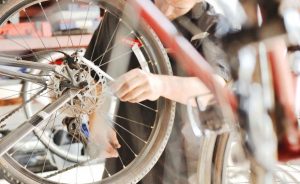Bicycling in Florida
 In Florida the bicycle is legally defined as a vehicle and the bicyclist is a driver. Bicyclists have the same rights to the roadways, and must obey the same traffic laws as the drivers of other vehicles. These laws include stopping for stop signs and red lights, riding with the flow of traffic, using lights at night, yielding the right-of-way when entering a roadway and yielding to pedestrians in crosswalks.
In Florida the bicycle is legally defined as a vehicle and the bicyclist is a driver. Bicyclists have the same rights to the roadways, and must obey the same traffic laws as the drivers of other vehicles. These laws include stopping for stop signs and red lights, riding with the flow of traffic, using lights at night, yielding the right-of-way when entering a roadway and yielding to pedestrians in crosswalks.
There is only one road and it is up to bicyclists and motorists to treat each other with care and respect. Adherence to the law is the foundation for this respect, but the law itself is simply a codification of the rules of movement that make all road users predictable to one another.
Tips to avoid accidents
There are things that both automobile drivers and bicyclists can do to avoid accidents. Some are pretty common sense; others are simple reminders that you are not alone on the roads.
8 tips for automobile drivers: Avoiding an accident with a bicyclist:
- Drive at a speed that is safe for conditions. Slow down on wet or icy roads as you will need more time to come to a stop.
- Be careful on two lane roads. A majority of accidents occur on these narrow roads where traffic is moving at a high speed.
- Two-thirds of bicycle accidents nationwide occur in the late afternoon and evening due to poor visibility. Be especially careful in early morning and evening hours when glare on your windshield can impair your vision. Keep your windshield clear of dirt and waste.
- Pull over to the side of the road, if you need to consult a map or talk on your cell phone, especially when cyclists are often present. Distracted driving is a significant cause of collisions involving bicyclists.
- Don’t drink and drive.
- Always check your mirrors and proceed slowly when backing out of driveways and parking lots. Almost 75% of all bicycle accidents nationwide occur at intersections and driveways.
- Slow down when moving through an intersection, and always come to a complete stop at a stop sign. Watch for cyclists at other entrances to the intersection. Check your mirrors and blind spots for any cyclists behind or beside your vehicle when making turns.
- Don’t assume that cyclists will give right-of-way.
12 tips for bicyclists: avoiding an accident with an automobile:
- Keep in mind that not all drivers feel it is their duty to share the road with cyclists, and few drivers check their mirrors and blind spots as often as they should.
- Failure to yield, riding against traffic, stop sign violations, and safe movement violations are the most common mistakes that bicyclists make to cause an accident.
- Wear a helmet. Although this can not protect against an accident, it can protect you from serious injury or even death.
- Be visible. Wear reflective tape for night riding and equip your bike with a light.
- Never make a left hand turn from a designated bike path. Instead, merge into left hand lane of traffic and do not cut in front of other drivers, who may not be able to see you.
- Do not ride alongside cars when passing through an intersection. A driver may turn in front of you without warning.
- Always merge into normal traffic lanes from your bike lane as you approach an intersection.
- Pay attention when passing parked cars, as car passengers can open their doors suddenly.
- Keep both hands on your handlebars to maintain maximum control of your bicycle.
- Equip your bike with mirrors and check them frequently while riding.
- Know the hand signals and make them consistently before turning.
- Pay attention in the late afternoon and evening hours when the sun can cause visibility problems for drivers.
If you have bicycle injuries in Florida, contact Adam Franzen today.
Even following these tips, you may still be involved in a bicycle accident. Call Adam Franzen at (954) 462-5790 as soon after an accident as possible. He has many years of knowledge and experience in Florida bicycle laws and can help you if you have injuries or damage. Visit his website to learn more about how he can help you with your bicycle and other personal injury cases.
This entry was posted on Wednesday, September 28th, 2016 at 4:59 am and is filed under Blog. You can follow any responses to this entry through the RSS 2.0 feed. Both comments and pings are currently closed.







